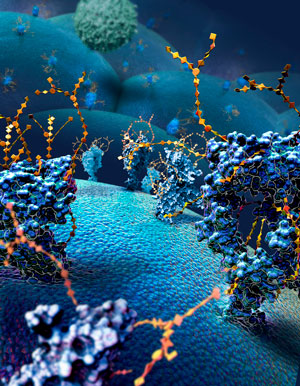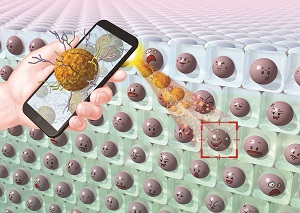Sep. 7, 2018 Research Highlight Biology
Sugar chain complexes affect cancer cell binding
A strategy for examining the effects of sugar chain clusters on different cell types could lead to more targeted delivery of drugs
 Figure 1: Glycans (gold) attached to proteins, collectively known as glycoproteins, are shown here interacting with a cancer cell's surface. RIKEN researchers have identified a pattern recognition mechanism involving heterogeneous glycoclusters that could help drugs target cancer cells more effectively. © 2018 Nicolle R. Fuller /Science Photo Library
Figure 1: Glycans (gold) attached to proteins, collectively known as glycoproteins, are shown here interacting with a cancer cell's surface. RIKEN researchers have identified a pattern recognition mechanism involving heterogeneous glycoclusters that could help drugs target cancer cells more effectively. © 2018 Nicolle R. Fuller /Science Photo Library
RIKEN researchers have uncovered important differences in how strongly sugar chain clusters bind to different tumor cells1. This discovery could be used to design drug-delivery systems that target tumors even more specifically.
The surfaces of cells are decorated with chains of sugar molecules called glycans, which enable cells to talk to each other and detect harmful pathogens. The binding of glycans to proteins, glycans and lipids on the cell surface promotes the growth and proliferation of cells, especially cancerous ones. Using such glycan-based interactions is hence a promising strategy for targeting cancer cells.
Now, Katsunori Tanaka of the RIKEN Cluster for Pioneering Research and colleagues have examined the binding of synthetic glycoclusters linked to the serum protein albumin to various types of cancer cells in both cell and animal assays.
To investigate the effects of sugar chain clusters on cancer cell binding, the team used a method they had previously developed to generate seven well-defined glycocluster-linked albumins and labeled them with a fluorescent dye.
The researchers then incubated these synthesized molecules with different cancer cell lines and determined the extent of cell binding by measuring the fluorescence. They found that even small differences between the glycoclusters significantly affected the strength with which the glycocluster-linked albumins bound to specific cell types. In particular, cell binding was affected by differences between the glycans in the glycocluster, positioning of glycans within a cluster and the electric charge of the glycans.
 Figure 2: Using glycans to target cancer cells through pattern recognition mechanisms promises to lead to drugs that attack cancer cells more specifically. © 2018 RIKEN Cluster for Pioneering Research
Figure 2: Using glycans to target cancer cells through pattern recognition mechanisms promises to lead to drugs that attack cancer cells more specifically. © 2018 RIKEN Cluster for Pioneering Research
To further assess the effects of these molecules on tumor accumulation, the team injected them into mice implanted with various tumor tissues. They used non-invasive fluorescence imaging to compare the distribution of glycocluster-linked albumins in the body and their excretion rate. Interestingly, the binding affinities observed in the cell-based experiments did not always translate to an accumulation in implanted tumors, highlighting the importance of examining the effects of glycoclusters in the context of complex biological systems.
“We are the first to prove that glycan pattern recognition exists experimentally and affects tumor targeting,” notes Tanaka.
The team is collaborating with industry to prepare glycocluster-conjugated drugs that quickly and selectively bind to their target, which will reduce side effects. “If we can mimic this glycan pattern recognition, we will be able to make drug-delivery systems that are much more selective than conventional antibodies or nanoparticles,” explains Tanaka.
 Dr. Katsunori Tanaka and the lab members. © RIKEN
Dr. Katsunori Tanaka and the lab members. © RIKEN
His team’s ultimate goal is to trigger the synthesis of bioactive therapeutic compounds in living animals where and when required. Understanding glycan pattern recognition will help direct glycocluster-linked biomolecules to desired organs and avoid some of the problems with current drug treatments.
Related contents
- A golden opportunity for drug targeting
- Glycocluster design could lead to targeted drug delivery
- Drug production inside our bodies
References
- 1. Ogura, A., Urano, S., Tahara, T., Nozaki, S., Sibgatullina, R., Vong, K., Suzuki, T., Dohmae, N., Kurbangalieva, A., Watanabe, Y. et al. A viable strategy for screening the effects of glycan heterogeneity on target organ adhesion and biodistribution in live mice. Chemical Communications 54, 8693−8696 (2018). doi: 10.1039/C8CC01544A
